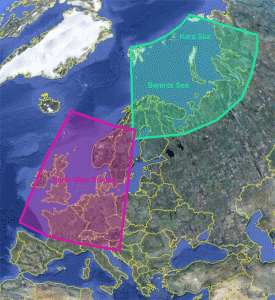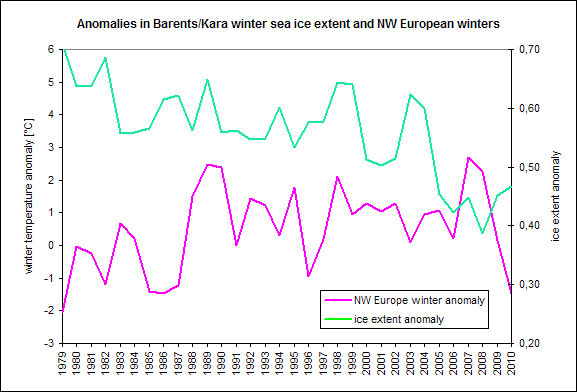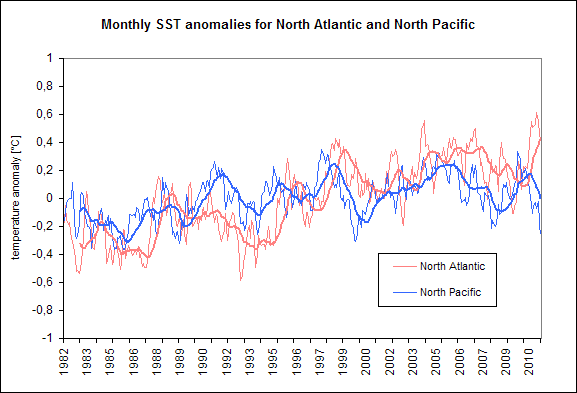According to climate models of the Potsdam Institute for Climate Impact Research (PIK) in Potsdam Germany, the recent cold winters in Europe are caused by low sea ice extent (due to AGW) in the Barents and Kara Seas. Juraj Vanovcan now has an essay that shows the opposite seems to be true.
Debunking PIK’s Low Barents/Kara Sea Ice – Cold Winters Claim
By guest writer Juraj Vanovcan
In dealing with three consecutive cold winters in NW Europe, orthodox climatology is now doing all it can to avoid mentioning the changing trends in NAO/AO and the cooling Atlantic. Instead, various bizarre theories have been floated out – from the Big Oil slick in the Gulf of Mexico slowing down the Gulf Stream, to tremendous melting of Greenland ice sheets having the same effect. They all ignore the fact that the Gulf Stream is powered by tropical trade winds.
Another tactic that warmists have used for damage control is claiming that low sea ice extent in Barents and Kara Sea may cause changes in air circulation, thus allowing cold Arctic air to pour down to the mid-latitudes. But this theory is dubious, as we shall see. It is the prevailing direction of air circulation and not the “increased greenhouse effect” that rules the European winters.
Such attempts to tie the cold with warm elsewhere, here the alleged decrease of ice cover in a part of the Arctic, reminds us of Kevin Trenberth’s search for the “missing heat”.
Climate data are freely available via KNMI Climate Explorer, so let’s investigate the PIK claim.
Figure 1 shows the area of Barents and Kara Sea (65-80N, 10-100E), and North-West Europe (45-70N, 10W-15E), where it is being claimed low winter ice extent there is causing low winter temperatures and snow in Europe.
Figure 2 shows winter (D-J-F) ice extent in Barents and Kara Sea, combined with winter temperature anomalies over the Northwest Europe.
Figure 2 Barents/Kara winter sea extent and NW Europe winters, 1979-2010.
Eyeballing the relation between those two curves, there is a relation, but the opposite of what is claimed by PIK! For example, low winter sea ice extent in 2007 and 2008 were tied with mild European winters. Also cold winters in the mid-1980s happened despite rather high ice extent in Barents and Kara Sea. Figure 3 as follows shows the two parameters in direct relation:
Figure 3 Relation between Barents/Kara winter sea ice extent and NW European winters, 1979-2010.
Mathematicians could argue about the statistical significance of observed trend, but the trend itself is rather logical: Cold Barents/Kara Sea with more ice means cold winters in Northwest Europe. One does not know yet, where the 2010/2011 winter plot will appear on the graph above, but even if it is an outlier it will not change the overall trend.
The claim that cold European winters are caused by low ice extent in Barents and Kara Sea is therefore not supported by observed data.
Since the Arctic ice extent depends mainly on North Atlantic SST, as presented elsewhere, there is a good chance that in near future we will see remarkable growth. Figure 4 shows the North Pacific and North Atlantic SST monthly anomalies, based on Reynolds OI.v2 dataset.
Figure 4: Monthly SST anomalies for North Pacific and North Atlantic since 1982.
There seems to be a 1-year lag between the two plots, with the Atlantic trailing the Pacific SST trend. Warm SST peak in Atlantic, observed in 2010, seems to mimic similar event in North Pacific in 2009. But Pacific SST have since dropped to levels seen only in the 80s. If the Atlantic follows, then 2011 summer sea ice extent may see a considerable gain.
Future attempts to explain increasing Arctic ice cover with warming somewhere else will no doubt raise more amusement and doubts about the ”scientific consensus”.









Hi Pierre, the Fig 1 graph is missing.
My computer shows all four graphics.
Has anyone seen a missing graphic anywhere?
no. I can see all 4 graphics.
Sorry folks, everything is OK. Now, where exactly is the logic in PIK’s claim?
There is no logic. It’s PIK climate-speak. We are now living under the eco-tyranny.
Don’t worry guys. The winter in Germany is over 😉
http://www.wetter24.de/de/home/wetter/wetter-news/news/ch/8cbc8c1a3829da305d557ad78e05e958/article/winter_pause.html
Until about January 18, it appears.
If I were you I’d better watch the Oder river:
http://www.wetter24.de/de/home/wetter/wetter-news/news/ch/e94f8413bfb608252490c936cd399d1a/article/fruehjahrs_hochwasser.html
http://www.spiegel.de/reise/aktuell/0,1518,738030,00.html
My grandmother used to say: “Those who tend to lie as an child, will later become meteorologists.” So…the winter is over when its over. 😉
and don´t forget Global Warming Skeptic Piers Corbyn
http://www.youtube.com/watch?v=MFVQluPDV8c&feature=player_embedded
worth listening to…
…and finally:
Met Office knew big freeze was coming but hushed it up
http://www.dailymail.co.uk/news/article-1343863/Met-Office-knew-Decembers-big-freeze-coming-hushed-up.html
Another hot sea is freezing ships to the rescue.
And than there were still five
http://eureferendum.blogspot.com/2011/01/and-then-there-were-still-five.html
Whilst you’re right to point out that there isn’t a significant negative correlation between sea ice concentration over the B-K sea and European winter temperatures, I don’t think that this “debunks” Petoukhov and Semenov as they don’t claim that there is such a correlation.
What they do say is that in a model with all other things being held equal there is a non-linear relationship between ice concentration in the B-K sea region and winter temperature (and winds) over Europe.
I suspect that to “debunk”, or verify, this finding using the actual sea ice and temperature measurements you’d have to pick apart the contributions of other factors (e.g. polar jet changes, ENSO teleconnections) and then find some way of characterising the non-linear nature of the relationship with B-K sea ice. Could be interesting!
“70 Trillion cubic feet of New Arctic Ice”
http://modernsurvivalblog.com/weather-preparedness/13-billion-cubic-feet-of-new-arctic-ice/
Ike
Two correlated graphs don’t mean there’s an actual physical relationship between them. You know, the birth rate in Europe correlates with the number of storches.
So if you’ve got no mechanism that makes a relationship plausible, statistics have to cover several cycles, otherwise it’s manipulative, it’s bad science.
Anyway the relation between reduced Barents und Kara sea ice and cold European winters is not expected to work generally, but below a certain ice extent.
You’re talking about air circulation. But global temperature distribution is excatly what affects air circulation. The long term oscillation of the NAO- and AO index is thought to be driven by modifications in ocean temperatures that are responses to varying air circulation themselves.
Now there’s nothing that could have a greater impact on air temperature than lacking sea ice (instead of -25°C you’ve got 0°C). If the temperature gradient between continental mid latitudes and marine high latitudes reverses or weakens significantly, the typical winter circulation dominated by westerlies breaks down. And you know what happens than.
Still I have to say, claiming that one cold winter was “caused” by one single parameter such as sea ice is ridiculous. There are so many factors working and even if you know many of them you can just see tendencies – it’s not possible to forecast one single winter.